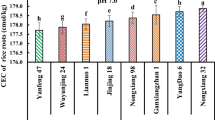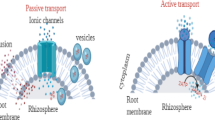Abstract
Aim
This article was aimed to explore the main rhizospherial properties of the Cd hyperaccumulator R. globosa compared to those of the non hyperaccumulator Rorippa palustris (Leyss.) Bess. representing the same genus (Rorippa) of Cruciferae.
Method
Pot culture experiments using soil spiked with Cd as CdCl2·2.5H2O and rhizobags were conducted to determine the differences in Cd accumulation vs. pH, dissolved organic carbon (DOC), Cd chemical fractionation, enzyme activities, and microorganism number in the rhizospheres of R. globosa and R. palustris, and in the bulk soils.
Results
Experiments on Cd uptake by R. globosa and R. palustris from soil spiked with different doses of Cd ranging from 0 to 40 mg∙kg−1, confirmed Cd-hyperaccumulating properties of R. globosa (Cd accumulation in the above-ground organs >100 mg kg−1, enrichment factor EF> 1, translocation factor TF> 1, no significant biomass reduction at Cd doses >10 mg kg−1) and the lack of such properties in R. palustris, which made these species suitable for comparative studies. The pH value was found to be a constant, specific property of the rhizosphere of R. globosa and R. palustris, and of the bulk soil, independent on the Cd dose, however the differences were rather small: by 0.2 unit lower in the rhizosphere of R. globosa, and only by 0.1 unit lower in the rhizosphere of R.. palustris compared to the bulk soil. Chemical fractionation of Cd, i.e. its affinity to pools of different binding strength, also appeared to be a specific feature of a rhizosphere and soil independent on the Cd dose. It exhibited a unique capability of the rhizosphere of the Cd-hyperaccumulator R. globosa to mobilize Cd, which enriched the most labile exchangeable fraction in 24.4 % and the immobile residual fraction in 42.3 %, compared to 19.3 % and 50.8 % in the bulk soil and in the rhizosphere of the non-hiperaccumulator R.palustris that did not show significant difference (p < 0.05) from the bulk soil. In turn, DOC concentrations, enzymatic (urease and catalase) activity and microorganism (bacteria, fungi and actinomycetes) growth in rhizosphere soils were largely influenced by different Cd doses, although they were always considerably higher in the rhizosphere soils of R globosa, than in the rhizosphere of R. palustris and in the bulk soil, in particular at Cd doses ≥10 mg kg−1.
Conclusion
pH and DOC changes in the rhizosphere of the Cd-hyperaccumulator R. globosa were found to be of a minor importance. The alteration of Cd chemical fractionation consisting in substantial reduction of the immobile residual pool and Cd enrichment primarily in the most labile exchangeable fraction, along with over 2-fold higher number of microorganisms was considered to be the driving force of Cd hyperaccumulation.




Similar content being viewed by others
References
Aboudrar W, Schwartz C, Benizri E, Morel JL, Boularbah A (2007) Soil microbial diversity as affected by the rhizosphere of the hyperaccumulator Thlaspi caerulescens under natural conditions. Intern J Phytoremediat 9:41–52
Alford ÉA, Pilon-Smits EAH, Pashke MW (2010) Metallophytes – a view from the rhizosphere. Plant Soil 337:33–50
Baker AJM, Brooks RR (1989) Terrestrial higher plants which hyperaccumulate metallic elements - a review of their distribution, ecology and phytochemistry. Biorecovery 1:81–126
Boominathan R, Doran PM (2003) Organic acid complexation, heavy metal distribution and the effect of ATPase inhibition in hairy roots of hyperaccumulator plant species. J Biotechnol 101:131–146
Chaney RL, Malik M, Li YM, Brown SL, Brewer EP, Angle JS, Baker AJM (1997) Phytoremediation of soil metals. Curr Opin Biotechnol 8:279–284
Christensen JB, Christensen TH (1999) Complexation of Cd, Ni, and Zn by DOC in polluted groundwater: a comparison of approaches using resin exchange, aquifer material sorption, and computer speciation models (WHAM and MINTEQA2). Environ Sci Technol 33:3857–3863
Dessureault-Rompré J, Luster J, Schulin R, Tercier-Waeber ML, Nowack B (2010) Decrease of labile Zn and Cd in the rhizosphere of hyperaccumulating Thlaspi caerulescens with time. Environ Pollut 158:1955–1962
Epelde L, Becerril JM, Barrutia O, Gonza´lez-Oreja JA, Garbisu C (2010) Interactions between plant and rhizosphere microbial communities in a metalliferous soil. Environ Pollut 158:1576–1583
Fitz WJ, Wenzel WW, Zhang H, Nurmi J, Stipek K, Fischerova Z, Schweiger P, Kollensperger G, Ma LQ, Stingeder G (2003) Rhizosphere characteristics of the arsenic hyperaccumulator Pteris vittata L. and monitoring of phytoremoval efficiency. Environ Sci Technol 37:5008–5014
Gonzaga MIS, Ma LQ, Santos JAG, Matias MIS (2009) Rhizosphere characteristics of two arsenic hyperaccumulating Pteris ferns. Sci Total Environ 407:4711–4716
Hammer D, Keller C (2002) Changes in the rhizosphere of metal-accumulating plants evidenced by chemical extractants. J Environ Qual 31:1561–1569
He L-Y, Chen Z-J, Ren G-D, Zhang Y-F, Qian M, Sheng X-F (2009) Increased cadmium and lead uptake of a cadmium hypraccumulator tomato by cadmium-resistant bacteria. Ecotox Environ Safe 72:1343–1348
Jones DL, Willett VB (2006) Experimental evaluation of methods to quantify dissolved organic nitrogen (DON) and dissolved organic carbon (DOC) in soil. Soil Biol Biochem 38:991–999
Kabata-Pendas A (2010) Trace elements in soil and plants, 4th edn. CRC Press, Taylor & Francis Group, Boca Raton
Karimzadeh L, Heilmeier H, Merkel BJ (2012) Effect of microbial sideropore DFO-B on Cd accumulation by Thlaspi caerulescens hyperaccumulator in the presence of zeolite. Chemosphere 88:683–687
Keller C, Hammer D, Kayser A, Richner W, Brodbeck M, Sennhauser M (2003) Root development and heavy metal phytoextraction efficiency: comparison of different plant species in the field. Plant Soil 249:67–81
Kidd PS, Becerra-Castro C, Garcia-Lestón M, Monterroso C (2007) Aplicación de plantas hiperacumuladoras de niquel en la fitoextracción natural: et género Alyssum L. Ecosistemas 16:26–43
Kuffner M, Puschenreiter M, Wieshammer G, Gorfer M, Sessitsch A (2008) Rhizosphere bacteria affect growth and metal uptake of heavy metal accumulating willows. Plant Soil 304:35–44
Li TQ, Di ZH, Islam E, Jiang H, Yang X (2011a) Rhizosphere characteristics of zinc hyperaccumulator Sedum alfredii involved in zinc accumulation. J Hazard Mater 185:818–823
Li TQ, Di Z, Yang X, Sparks DL (2011b) Effect of dissolved organic matter from the rhizosphere of the hyperaccumulator Sedum alfredii on sorption of zinc and cadmium by different soils. J Hazard Mater 192:1616–1622
Liang W, Wu ZB, Cheng SP, Zhou QH, Hu HY (2003) Roles of substrate microorganisms and urease activities in wastewater purification in a constructed wetland system. Ecol Eng 21:191–195
Lombi E, Zhao FJ, McGrath SP, Young SD, Sacchi GA (2001) Physiological evidence for a high-affinity cadmium transporter highly expressed in a Thlaspi caerulescens ecotype. New Phytol 149:53–60
McGrath SP, Shen ZG, Zhao FJ (1997) Heavy metal uptake and chemical changes in the rhizosphere of Thlaspi caerulescens and Thlaspi ochroleucum grown in contaminated soils. Plant Soil 188:153–159
Morera MT, Echeverria JC, Mazkiaran C, Garrido JJ (2001) Isotherms and sequential extraction procedures for evaluating sorption and distribution of heavy metals in soils. Environ Pollut 113:135–144
Nedelkoska TV, Doran PM (2001) Hyperaccumulation of Cadmium by Hairy Roots of Thlaspi caerulescens. Biotechnol Bioeng 67:607–615
Qiu RL, Zhao X, Tang YT, Yu FM, Hu PJ (2008) Antioxidative response to Cd in a newly discovered cadmium hyperaccumulator, Arabis paniculata. Chemosphere 74:6–12
Sessitsch A, Kuffner M, Kidd P, Vangronsveld J, Wenzel WW, Fallman K, Puschenreiter M (2013) The role of plant-associated bacteria in the mobilization and phytoextractiom of trace elements in contaminated soil. Soil Biol Biochem 60:182–194
Stepniewska Z, Wolińska A, Ziomek J (2009) Response of soil catalase activity to chromium contamination. J Environ Sci 21:1142–1147
Su H, Cai Z, Zhou Q (2013) Phytoremediation of cadmium contaminated soils. Advances and researching prospects, Mater. Sci. Forum 743–744:732–744
Sun RL, Zhou QX, Wei SH (2011) Cadmium accumulation in relation to organic acids and non-protein thiols in leaves of the new-found Cd-hyperaccumulator Rorippa globosa and the Cd-accumulating plant Rorippa islandica. J Plant Growth Regul 30:83–91
Tessier A, Campbell PGC, Bisson M (1979) Sequential extraction procedure for the speciation of particulate trace metals. Anal Chem 51:844–851
van der Ent A, Baker AJM, Reeves RD, Pollard AJ, Schat H (2013) Hyperaccumulators of metal and metalloid trace elements: Facts and fiction. Plant Soil 362:319–334
Wangeline AL, Valdez JR, Lindblom SD, Bowling KL, Reeves FB, Pilon-Smits EAH (2011) Characterization of rhizosphere fungi from selenium hyperaccumulator and nonhyperaccumulator plants along the eastern rocky mountain front range. Am J Botany 98:1139–1147
Wei SH, Zhou QX, Wang X, Zhang KS, Guo GL, Ma LQ (2005) A newly-discovered Cd-hyperaccumulator Solanum nigrum L. Chin Sci Bullet 50:33–38
Wei SH, Zhou QX, Saha UK (2008) Hyperaccumulative characteristics of weed species to heavy metals. Water Air Soil Pollut 192:173–181
Wei SH, Li YM, Zhan J, Wang SS, Zhu JG (2012) Tolerant mechanisms of Rorippa globosa (Turcz.) Thell. hyperaccumulating Cd explored from root morphology. Biores Tech 118:455–459
Wenzel WW (2009) Rhizosphere processes and management in plant-assisted bioremediation (phytoremediation) of soils. Plant Soil 321:385–408
Wenzel WW, Bunkowski M, Puschenreiter M, Horak O (2003) Rhizosphere characteristics of indigenously growing nickel hyperaccumulator and excluder plants on serpentine soil. Environ Pollut 123:131–138
Whiting SN, Leake JR, McGrath SP, Baker AJM (2001) Zinc accumulation by Thlaspi caerulescens from soils with different Zn availability: a pot study. Plant Soil 236:11–18
Xie HL, Jiang RF, Zhang FS, McGrath SP, Zhao FJ (2009) Effect of nitrogen form on the rhizosphere dynamics and uptake of cadmium and zinc by the hyperaccumulator Thlaspi caerulescens. Plant Soil 318:205–215
Xiong JB, He ZL et al (2008) The role of bacteria in the heavy metals removal and growth of Sedum alfredii Hance in an aqueous medium. Chemosphere 70:489–494
Zhang X, Zhang S, Xu X, Li T, Gong G, Jia Y (2010) Tolerance and accumulation characteristics of cadmium in Amaranthus hybridus L. J Hazard Mater 180:303–308
Zhao FJ, Hamon RE, McLaughlin MJ (2001) Root exudates of the hyperaccumulator Thlaspi caerulescens do not enhance metal mobilization. New Phytol 151:613–620
Acknowledgements
This work was supported by the National Natural Science Foundation of China (31270540, 31070455, 40971184 and 40930739), the National Science & Technology Pillar Program (2012BAC17B04), Hi-tech research and development program of China (2012AA06A202), and Natural Science Foundation of Liaoning Province, China (201102224).
Author information
Authors and Affiliations
Corresponding author
Additional information
Responsible Editor: Tim Simon George.
Rights and permissions
About this article
Cite this article
Wei, S., Twardowska, I. Main rhizosphere characteristics of the Cd hyperaccumulator Rorippa globosa (Turcz.) Thell. Plant Soil 372, 669–681 (2013). https://doi.org/10.1007/s11104-013-1783-0
Received:
Accepted:
Published:
Issue Date:
DOI: https://doi.org/10.1007/s11104-013-1783-0




